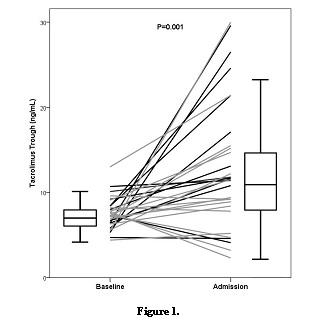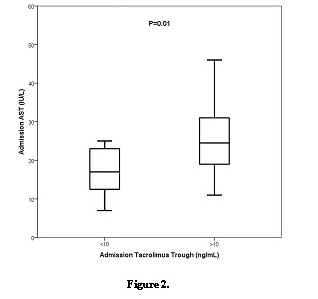Elevated Tacrolimus Levels in Hospitalized Organ Transplant Recipients with COVID-19
1Department of Pharmacy, Rhode Island Hospital, Providence, RI, 2Department of Internal Medicine, Residency, Warren Alpert Medical School of Brown University, Providence, RI, 3Division of Infectious Diseases, Warren Alpert Medical School of Brown University, Providence, RI, 4Division of Nephrology, Warren Alpert Medical School of Brown University, Providence, RI, 5Department of Surgery (Transplantation), Warren Alpert Medical School of Brown University, Providence, RI
Meeting: 2021 American Transplant Congress
Abstract number: LB 55
Keywords: COVID-19, Immunosuppression
Topic: Clinical Science » Infectious Disease » COVID-19
Session Information
Session Name: COVID-19
Session Type: Poster Abstract
Session Date & Time: None. Available on demand.
Location: Virtual
*Purpose: The effect of COVID-19 on immunosuppressant drug levels in organ transplant recipients (OTRs) has not been adequately studied.
*Methods: We retrospectively studied hospitalized adult (>18-year-old) OTRs with COVID-19, who were receiving tacrolimus and were hospitalized between 3/1 and 12/16/2020. Categorical data were compared by Fisher’s exact test, and continuous by the Mann-Whitney and Wilcoxon rank sum tests for unrelated or paired samples, respectively.
*Results: We studied 30 OTRs. 67% were men, 90% had a kidney transplant. Two were heart transplant and one small intestine transplant recipients. Median age was 60.5 (range 21-84) years, median time from transplant 36 (range: 1-224) months. Tacrolimus troughs were significantly higher on admission for COVID-19 than baseline (average trough in the 6 months prior): median 11.5 vs. 7.4 ng/mL, P=0.001; Fig. 1. Patients with diarrhea had higher tacrolimus trough levels, compared to those without diarrhea (P=0.09). We found no significant association between tacrolimus trough and acute kidney injury or bacterial infections. Compared to OTRs with tacrolimus trough <10 ng/mL, those with trough >10 ng/mL were more likely to have elevated aspartate aminotransferase (AST) on admission (P=0.01, Fig. 2) and require supplemental oxygen during hospital admission (P=0.026, Fig. 1: black lines represent OTR requiring supplemental oxygen).
*Conclusions: Tacrolimus trough levels were substantially elevated in most OTRs with COVID-19 at the time of hospital admission, compared to baseline. In OTRs with COVID-19, including outpatients, immunosuppressant drug levels should be closely followed; management of immunosuppression should be individualized.
To cite this abstract in AMA style:
Mecadon K, Hardesty A, Vieira K, Rogers R, Merhi B, Osband AJ, Bayliss G, Gohh R, Morrissey P, Farmakiotis D. Elevated Tacrolimus Levels in Hospitalized Organ Transplant Recipients with COVID-19 [abstract]. Am J Transplant. 2021; 21 (suppl 3). https://atcmeetingabstracts.com/abstract/elevated-tacrolimus-levels-in-hospitalized-organ-transplant-recipients-with-covid-19/. Accessed December 28, 2025.« Back to 2021 American Transplant Congress


